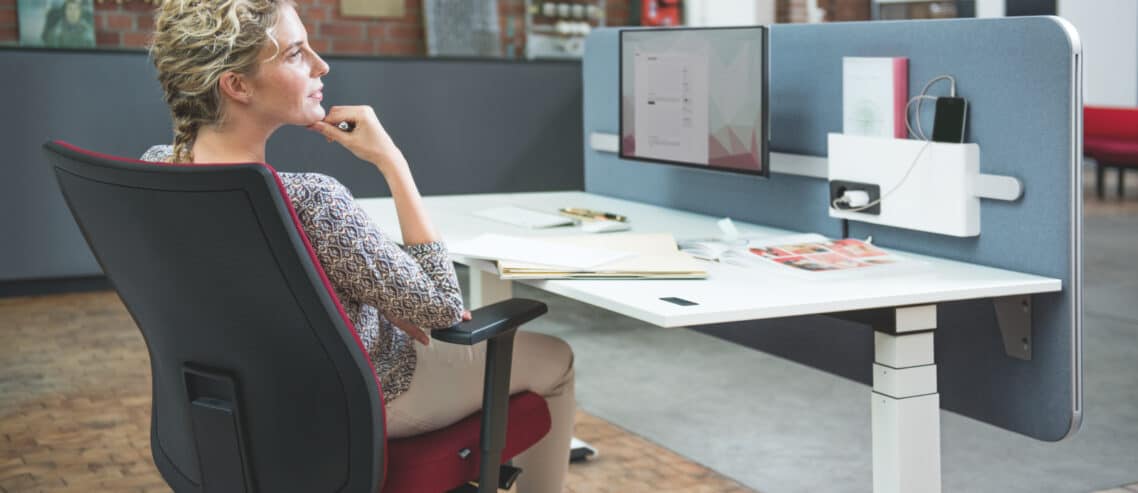Get an Ergonomic Desk: Because Where You Work Matters
An ergonomic desk can be the centerpiece of any workstation and a worker’s best friend.
When working from home, we quickly discovered the physical and psychological benefits of working from a proper desk. Dining room tables and coffee tables are made for dining and coffee, not reading, typing and answering phones.
And whether you are at home or in an office, a good ergonomic desk can boost your well-being and productivity. Let’s go over all the aspects of what makes a desk “ergonomic” and how to choose the right one.
What is an ergonomic desk?
An ergonomic desk can reduce the time you spend in a static position throughout the day. Ergonomic furniture and equipment improve the set-up of your workstation, increase comfort, and reduce the risk of injury.
The most common injuries sustained from improper working conditions are musculoskeletal conditions. According to the WHO, musculoskeletal conditions are the leading contributor to disability worldwide. Lower back pain is the single leading cause of disability in 160 countries.1 An ergonomic desk paired with an ergonomic chair and proper usage can significantly decrease your chances of developing musculoskeletal disorders.
What should I look for in an ergonomic desk?
You may feel overwhelmed when you’re faced with all the different desk options out there. These guidelines will help you choose the right desk for your ergonomic workstation.
Adjustable height
Most people, particularly office workers, don’t engage in enough movement throughout the day. While it may seem like a standing desk is the natural solution, that may not be the case. Excess pressure can build on the spine and legs when workers stand for extended periods. Ergonomic experts agree that the best ergonomic workstation incorporates healthy movement. This means a desk that can be easily adjusted to different heights, preferably motorized. It’s also known as a sit-stand desk.
Enough clearance for your thighs, legs, and feet
That stylish, minimalist desk you saw on sale might “look perfect” in your home office. But it may not be the right height for you. Your desk is at the correct height if your legs fit comfortably under the desk with your feet flat on the floor. There should be enough space to cross your legs. If needed, a footrest can provide extra support. If your legs don’t fit properly under the desk or your knees can’t comfortably rest at a 90-degree angle in a neutral position, you may end up with constricted blood flow to your legs.
Keyboard tray
Your desk is at a proper height if the angle between your forearm and upper arm is between 90 and 110 degrees when you are seated there. Keyboard trays are a great ergonomic solution. These are specially designed to allow users to align their arms, wrists, and hands while typing at their office desks. Keyboard trays can help position your keyboard and mouse at the correct height. But they also help free up your workspace for other tasks. Keyboard trays can provide proper support for your wrists, so they’re not suspended or resting on a hard surface. You can maximize this feature with an ergonomic keyboard, too.
When you add a keyboard tray to the desk, you can drop it to a more ergonomic position. If you’re working on a standard height desk, this will allow you to type with your wrists straight and lower. If you’ve been accommodating desk height with a chair that is too tall, you can now lower the office chair. This will naturally lower your body and eyes in relation to where your monitors sit on the desk. The extra 3″ to 6″ could make a huge difference in how you’re viewing your monitors. It may effectively reduce eye strain and stress that is likely being applied to your neck and shoulders.
Enough space between the user and monitor
A poorly placed monitor can be the cause of many health issues, including head, neck, and shoulder pain. A monitor that’s too close will strain your eyes. Placing it too far away can tempt you to slump forward. Your monitor should rest about 20 inches in front of you or an arm’s length. It should also be at an angle between 10-20 degrees.
The right environment
When setting up ergonomic desks, it can be easy to get hyper-focused on the features of the desk. But the environment is also important. Your ergonomic desk should be placed in an area without harsh lighting. Bright lights can cause glare that may lead you to lean forward to better see your screen. This puts excess pressure on your neck, spine, and shoulders. It can also cause eye strain, one of the most common injuries experienced by workers who consistently use computer monitors.
The importance of an ergonomic desk
When you have the right equipment and furniture, your ergonomic office space becomes more conducive to productivity and preventing injury. While an ergonomic desk is essential, you should also do further reading on additional equipment like ergonomic chairs. These can be equally helpful in providing lower back support and aligning the spine’s natural curve.
Talk to coworkers if you’re unsure whether your office workstations are ergonomic. Ask if they experience any discomfort when they spend extensive time at their desk. Note whether their monitors sit properly at eye level or whether they have to use a laptop stand. Is their desk height adjustable? Is it in the budget to purchase all new sit-stand desks?
Office wellness with an ergonomic desk
When looking for an ergonomic desk, look no further than the solutions offered at Sedus. With award-winning design and state-of-the-art innovation, you’ll find all the ergonomic furniture your office needs. Contact them today to find out how you can make your office furniture more modern, stylish, and ergonomic.
1 Musculoskeletal health – WHO
